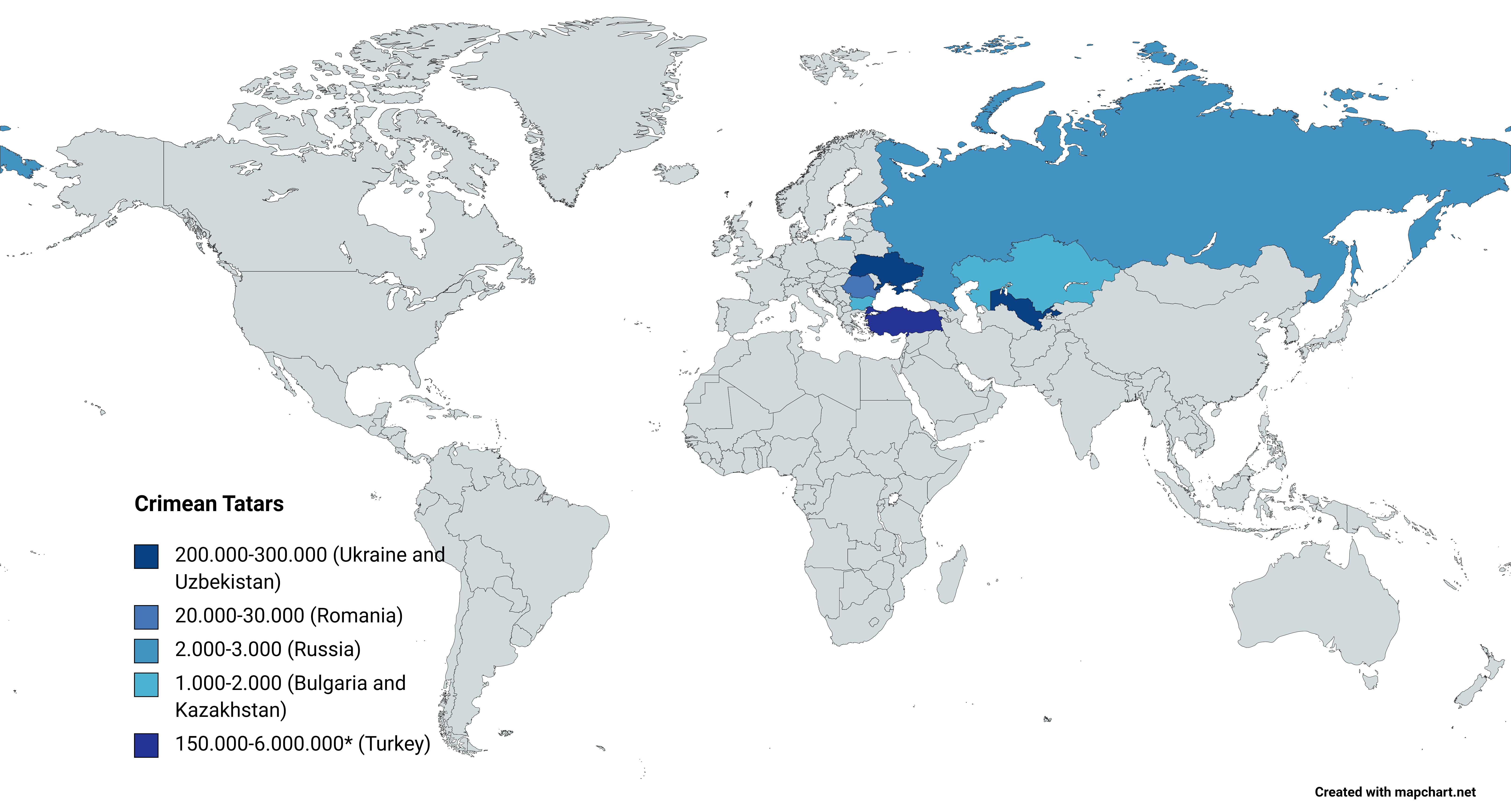|
Crimean Tatar Language
Crimean Tatar (), also called Crimean (), is a Turkic languages, Turkic language spoken in Crimea and the Crimean Tatar diasporas of Uzbekistan, Turkey and Bulgaria, as well as small communities in the United States and Canada. It should not be confused with Tatar language, Tatar, spoken in Tatarstan and adjacent regions in Russia; Crimean Tatar has been extensively influenced by nearby Oghuz languages and is mutually intelligible with them to varying degrees. A long-term ban on the study of the Crimean Tatar language following the deportation of the Crimean Tatars by the Soviet government has led to the fact that at the moment UNESCO ranks the Crimean Tatar language among the languages under serious threat of extinction (''severely endangered''). However, according to the A. Yu. Krymskyi Institute of Oriental Studies, Institute of Oriental Studies, due to negative situations, the real degree of the threat has elevated to critically endangered in recent years, which are highl ... [...More Info...] [...Related Items...] OR: [Wikipedia] [Google] [Baidu] |
Crimean Tatars
Crimean Tatars (), or simply Crimeans (), are an Eastern European Turkic peoples, Turkic ethnic group and nation indigenous to Crimea. Their ethnogenesis lasted thousands of years in Crimea and the northern regions along the coast of the Black Sea, uniting Mediterranean basin, Mediterranean populations with those of the Eurasian Steppe.''Агджоян А. Т., Схаляхо Р. А., Утевская О. М., Жабагин М. К., Тагирли Ш. Г., Дамба Л. Д., Атраментова Л. А., Балановский О. П.'Генофонд крымских татар в сравнении с тюркоязычными народами Европы, 2015 Genome-wide study of the Crimean Tatars unveiled connections between them and the genomes of individuals from the Steppe during the Bronze Age, specifically those associated with the Yamnaya culture, Yamnaya archaeological culture. Until the 20th century, Crimean Tatars were the most populous demographic cohort ... [...More Info...] [...Related Items...] OR: [Wikipedia] [Google] [Baidu] |
Ukraine
Ukraine is a country in Eastern Europe. It is the List of European countries by area, second-largest country in Europe after Russia, which Russia–Ukraine border, borders it to the east and northeast. Ukraine also borders Belarus to the north; Poland and Slovakia to the west; Hungary, Romania and Moldova to the southwest; and the Black Sea and the Sea of Azov to the south and southeast. Kyiv is the nation's capital and List of cities in Ukraine, largest city, followed by Kharkiv, Odesa, and Dnipro. Ukraine's official language is Ukrainian language, Ukrainian. Humans have inhabited Ukraine since 32,000 BC. During the Middle Ages, it was the site of early Slavs, early Slavic expansion and later became a key centre of East Slavs, East Slavic culture under the state of Kievan Rus', which emerged in the 9th century. Kievan Rus' became the largest and most powerful realm in Europe in the 10th and 11th centuries, but gradually disintegrated into rival regional powers before being d ... [...More Info...] [...Related Items...] OR: [Wikipedia] [Google] [Baidu] |
Crimea
Crimea ( ) is a peninsula in Eastern Europe, on the northern coast of the Black Sea, almost entirely surrounded by the Black Sea and the smaller Sea of Azov. The Isthmus of Perekop connects the peninsula to Kherson Oblast in mainland Ukraine. To the east, the Crimean Bridge, constructed in 2018, spans the Strait of Kerch, linking the peninsula with Krasnodar Krai in Russia. The Arabat Spit, located to the northeast, is a narrow strip of land that separates the Syvash lagoons from the Sea of Azov. Across the Black Sea to the west lies Romania and to the south is Turkey. The population is 2.4 million, and the largest city is Sevastopol. The region, internationally recognized as part of Ukraine, has been under Russian occupation of Crimea, Russian occupation since 2014. Called the Tauric Peninsula until the early modern period, Crimea has historically been at the boundary between the Classical antiquity, classical world and the Pontic–Caspian steppe, steppe. Greeks in pre-Rom ... [...More Info...] [...Related Items...] OR: [Wikipedia] [Google] [Baidu] |
Atlas Of The World's Languages In Danger
The UNESCO ''Atlas of the World's Languages in Danger'' was an online publication containing a comprehensive list of the world's endangered languages. It originally replaced the ''Red Book of Endangered Languages'' as a title in print after a brief period of overlap before being transferred to an online-only publication. History In 1992, the International Congress of Linguists (CIPL) meeting in Canada discussed the topic of endangered languages, as a result of which it formed the Endangered Languages Committee. It held an international meeting also in 1992 in Paris to place the topic before the world and initiate action. The meeting was considered important enough to come under the authority of UNESCO. At the instigation of Stephen Wurm the committee resolved to create a research center, the International Clearing House for Endangered Languages (ICHEL) and to publish the UNESCO ''Red Book of Endangered Languages'' based on the data it collected, the title being derived fr ... [...More Info...] [...Related Items...] OR: [Wikipedia] [Google] [Baidu] |
UNESCO
The United Nations Educational, Scientific and Cultural Organization (UNESCO ) is a List of specialized agencies of the United Nations, specialized agency of the United Nations (UN) with the aim of promoting world peace and International security, security through international cooperation in education, arts, sciences and culture. It has 194 Member states of UNESCO, member states and 12 associate members, as well as partners in the Non-governmental organization, non-governmental, Intergovernmental organization, intergovernmental and private sector. Headquartered in Paris, France, UNESCO has 53 regional field offices and 199 National Commissions for UNESCO, national commissions. UNESCO was founded in 1945 as the successor to the League of Nations' International Committee on Intellectual Cooperation.English summary). UNESCO's founding mission, which was shaped by the events of World War II, is to advance peace, sustainable development and human rights by facilitating collaboratio ... [...More Info...] [...Related Items...] OR: [Wikipedia] [Google] [Baidu] |
Dobrujan Tatar Dialect
Dobrujan Tatar is the Tatar language of Romania. It includes Kipchak dialects, but today there is no longer a sharp distinction between the dialects and it is mostly seen as one language. This language belongs to the Kipchak Turkic languages, specifically to the Kipchak-Nogai group. Name In Romania the language is commonly referred to as Tatar. However, some sources also use other names for it, including Romanian Tatar, Dobrujan Tatar, Danube Tatar, Budjak Tatar, Moldovan-Romanian Tatar, Nogai, Nogai-Tatar, Dobrujan Nogai, Budjak Nogai, Crimean Tatar, Dobrujan Crimean Tatar, Authentic Crimean Tatar and Colloquial Crimean Tatar. Dialects Traditional classification The grammar book by University of Bucharest identifies the following dialects: * Keríş * Şoñgar * Tat * Ğemboylîk * Ğedísan * Ğetíşkul Classification by Oghuz influence Some sources define the dialects according to their level of influence by Oghuz languages. # The language with moderate Oghuz i ... [...More Info...] [...Related Items...] OR: [Wikipedia] [Google] [Baidu] |
Council Of Europe
The Council of Europe (CoE; , CdE) is an international organisation with the goal of upholding human rights, democracy and the Law in Europe, rule of law in Europe. Founded in 1949, it is Europe's oldest intergovernmental organisation, representing 46 member states from Europe, with a population of approximately 675 million ; it operates with an annual ordinary budget of approximately 500 million euros. The organisation is distinct from the European Union (EU), although people sometimes confuse the two organisations – partly because the EU has adopted the original Flag of Europe, European flag, designed for the Council of Europe in 1955, as well as the Anthem of Europe, European anthem. No country has ever joined the EU without first belonging to the Council of Europe. The Council of Europe is an official United Nations General Assembly observers, United Nations observer. Unlike the EU, the Council of Europe cannot make binding laws; however, the council has produced a numbe ... [...More Info...] [...Related Items...] OR: [Wikipedia] [Google] [Baidu] |
Romania
Romania is a country located at the crossroads of Central Europe, Central, Eastern Europe, Eastern and Southeast Europe. It borders Ukraine to the north and east, Hungary to the west, Serbia to the southwest, Bulgaria to the south, Moldova to the east, and the Black Sea to the southeast. It has a mainly continental climate, and an area of with a population of 19 million people. Romania is the List of European countries by area, twelfth-largest country in Europe and the List of European Union member states by population, sixth-most populous member state of the European Union. Europe's second-longest river, the Danube, empties into the Danube Delta in the southeast of the country. The Carpathian Mountains cross Romania from the north to the southwest and include Moldoveanu Peak, at an altitude of . Bucharest is the country's Bucharest metropolitan area, largest urban area and Economy of Romania, financial centre. Other major urban centers, urban areas include Cluj-Napoca, Timiș ... [...More Info...] [...Related Items...] OR: [Wikipedia] [Google] [Baidu] |
Autonomous Republic Of Crimea
The Autonomous Republic of Crimea is a ''de jure'' administrative division of Ukraine encompassing most of Crimea that was unilaterally annexed by Russia in 2014. The Autonomous Republic of Crimea occupies most of the peninsula,Regions and territories: The Republic of Crimea while the City of Sevastopol (a within Ukraine) occupies the rest. The |
Federal Cities Of Russia
In the Russian Federation, a city of federal importance (), also known as a federal city, is a city that has a status of both an inhabited locality and a constituent federal subject. Russia has three federal cities: Moscow, Saint Petersburg, and Sevastopol, which was annexed in 2014 but remains internationally recognised as part of Ukraine. Moscow and Saint Petersburg are the largest cities in the country: Moscow is the national capital and Saint Petersburg is a former Russian capital and an important port city by the Baltic Sea. Currently, Sevastopol houses the Sevastopol Naval Base, the main port of the Russian Black Sea Fleet. See also * Oblasts of Russia *Republics of Russia * Krais of Russia *Jewish Autonomous Oblast The Jewish Autonomous Oblast (JAO) is a federal subject of Russia in the far east of the country, bordering Khabarovsk Krai and Amur Oblast in Russia and Heilongjiang province in China. Its administrative center is the town of Birobidzhan. ... [...More Info...] [...Related Items...] OR: [Wikipedia] [Google] [Baidu] |
Federal Subject Of Russia
The federal subjects of Russia, also referred to as the subjects of the Russian Federation () or simply as the subjects of the federation (), are the administrative division, constituent entities of Russia, its top-level political divisions. According to the Constitution of Russia, the federation consists of republics of Russia, republics, krais of Russia, krais, oblasts of Russia, oblasts, federal cities of Russia, cities of federal importance, an Jewish Autonomous Oblast, autonomous oblast, and autonomous okrugs of Russia, autonomous okrugs, all of which are equal subjects of the federation. Every federal subject has its own governor (Russia), head, a regional parliaments of Russia, parliament, and a constitutional court. Each subject has its own constitution or charter and legislation, although the authority of these organs differ. Subjects have equal rights in relations with federal government bodies. The subjects have equal representation – two delegates each – in ... [...More Info...] [...Related Items...] OR: [Wikipedia] [Google] [Baidu] |


